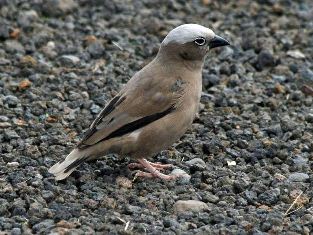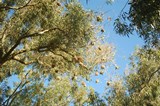Weaver species category
Choose different species category from drop-down list and press 'Go' button.Social weavers, genera Pseudonigrita and Philetairus
The social weavers are small, gregarious weavers of semi-arid parts in southern and East Africa. The sexes are similar in all three species. They forage on the ground, feeding mainly on seeds, and also insects. The species are colonial, monogamous, cooperative breeders, and build nests of straight grass stems. Both sexes add nest material throughout the year.Genus Pseudonigrita
There are two species in the genus Pseudonigrita, this name meaning "false waxbill". The two species are distinguished by having a grey or black cap, on which the English names are based.
The nests are clustered in groups in trees. Nests in a colony may touch or merge. Nests have two entrances and are used for roosting. In breeding nests one entrance is closed. The breeding nest is used by a single pair.
Genus Philetairus
There is one species in the genus Philetairus, this name meaning "loving companions".
The nest is a huge, domed, communal structure, with entrances underneath the nest mass. A common roof is shared by a large number of individual chambers.
The Pseudonigrita species
Grey-headed Social Weaver Pseudonigrita arnaudi
Black-capped Social Weaver Pseudonigrita cabanisi
The Philetairus species
Sociable Weaver Philetairus socius
Some differences in adult social weavers
| Species | Crown | Bill | Eye | Underparts |
| Grey-headed Social Weaver | grey | black | brown, white eye-ring | sandy brown |
| Black-capped Social Weaver | black | ivory | red | white, with central black line |
| Sociable Weaver | brown | blue-grey | dark brown | dull cream, black bib |













